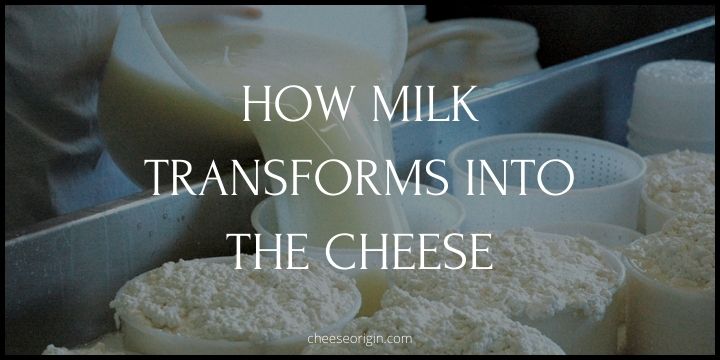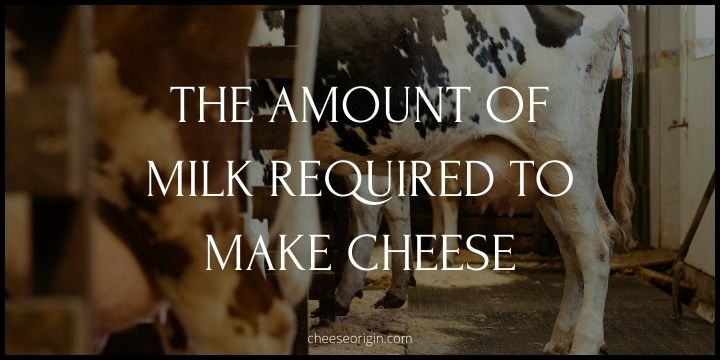Cheesemaking: How Milk Transforms into the Cheese We Love

Welcome, cheese aficionados and curious foodies alike! Today, we’re embarking on a culinary journey that promises to be as educational as it is delicious.
Have you ever nibbled on a piece of Gouda or savored a slice of Roquefort and wondered how these delightful morsels came to be?
The answer lies in a humble, everyday ingredient: milk.
In this post, we’ll traverse the milky road to cheesemaking, exploring how this simple liquid transforms into the diverse array of cheeses we adore.
From the pastures where our favorite dairy animals graze to the aging caves of artisan cheesemakers, we’ll uncover the secrets behind how milk’s unique properties shape the flavor, texture, and quality of cheese.
So, buckle up and prepare your palate for an exciting adventure into the world of cheesemaking!
Also read: The Science of Cheesemaking: A Journey from Milk to Artisanal Delight
4 Different Types of Milk in Cheesemaking
Cheese can be made with milk from cows, goats, sheep, and even buffalo. Each type of milk imparts a unique flavor profile to the cheese.
| Type of Milk | Description | Example Cheeses | Flavor Profile |
|---|---|---|---|
| Cow’s Milk | The most common type used in cheesemaking due to its high-fat content. | Cheddar, Brie | Rich, creamy |
| Goat’s Milk | Known for its distinct tangy flavor and smoother, creamier texture. Tends to be lighter and less fatty than cow’s milk cheese. | Chèvre | Tangy, smooth, creamy |
| Sheep’s Milk | High in protein and fat, it produces rich, creamy cheeses. | Roquefort, Manchego | Nutty, slightly sweet |
| Buffalo Milk | Incredibly rich and creamy, perfect for soft cheeses. | Mozzarella di Bufala | Rich, creamy |
The Composition of Milk and Its Impact on Cheese
Milk’s composition plays a significant role in determining the final product’s taste, texture, and quality. It consists mainly of water, but it’s the other components—fat, protein (casein), lactose, and minerals—that make cheese possible.
The fat in milk contributes to the richness, creaminess, and flavor of the cheese. The proteins, especially casein, are essential for curd formation. When these proteins coagulate, they form a network that traps fat and water, creating the curd that will eventually become cheese.
The lactose in milk is transformed into lactic acid during fermentation, influencing the cheese’s acidity level. This acidity plays a crucial role in the cheesemaking process as it affects the coagulation of proteins and the development of the cheese’s flavor and texture.
How Does Milk Turn Into Cheese?
Turning milk into cheese involves a fascinating process known as cheesemaking. Here’s a simplified overview of the steps involved:
- Acidification: The first step in cheesemaking is adding a starter culture, or bacteria to the milk. These bacteria consume the lactose (milk sugar) and produce lactic acid. This process changes the acidity level of the milk and begins the process of turning it into cheese.
- Coagulation: Next, an enzyme called rennet is added to the milk. Rennet causes the casein proteins in the milk to coagulate or clump together, forming curds.
- Cutting the Curds: The curd mass is cut into smaller pieces. This process helps to expel the whey, the watery part of the milk. The size of the curd pieces can affect the texture of the final cheese – smaller curds will produce a firmer cheese, while larger curds result in a softer cheese.
- Cooking and Washing the Curds: The curds may be heated to further expel whey, and sometimes washed to remove more lactose. Both these processes influence the cheese’s final texture and flavor.
- Pressing: The curds are then placed in a mold and pressed to remove any remaining whey and help the curds knit together into a solid mass. The pressure applied and duration of pressing depend on the type of cheese being made.
- Aging: The cheese is then aged, or ripened, for a specific period. During aging, bacteria continue to ferment lactose, and proteolytic enzymes break down proteins, both processes contributing to the development of flavor and texture in the cheese. The aging period can range from a few days to several years, depending on the type of cheese.
- Packaging: Once the cheese has reached its desired age, it’s packaged and ready for distribution.
This is a general process and can vary significantly depending on the type of cheese being made. Some cheeses, like cottage cheese, require fewer steps, while others, like blue cheese, have additional steps such as piercing to introduce air and promote mold growth.
How Do Bacteria Turn Milk Into Cheese?
The role of bacteria in cheesemaking is vital and multifaceted. Here’s how these microscopic organisms help transform milk into cheese:
| Role of Bacteria | Description |
|---|---|
| Acidification | The process starts with the addition of specific strains of bacteria, known as starter cultures, to the milk. These bacteria consume lactose, which is the sugar found in milk, and convert it into lactic acid through a process called fermentation. This increases the acidity of the milk, crucial for coagulation (the formation of curds). |
| Flavor Development | As the bacteria consume lactose and produce lactic acid, they also release other compounds that contribute to the taste, aroma, and texture of the cheese. These can include gases, which create holes in certain types of cheese, and diacetyl, which gives the cheese a buttery flavor. |
| Ripening | After the curd is formed, cut, and pressed into cheese, it often undergoes a ripening or aging process. During this stage, additional bacteria or molds are sometimes introduced, which continue to ferment the remaining lactose and proteins in the cheese. These secondary bacteria or molds can significantly influence the flavor, color, and texture of the cheese. For example, they can produce the blue veins in blue cheese or the distinctive washed rinds of cheeses like Gruyere. |
Bacteria play an essential role in cheesemaking, helping to transform liquid milk into a wide array of solid cheeses with diverse flavors, textures, and appearances.
7 Techniques That Impact Cheese Quality
Cheese quality is impacted by a variety of techniques and factors during the cheesemaking process. Here are some of the key methods and considerations that influence the quality of cheese:
1. Retention of Casein, Fat, and Moisture:
To achieve a high cheese yield and quality, cheesemakers need to retain as much casein (the primary protein in milk), fat, and moisture as possible. The balance of these components significantly affects the texture and flavor of the cheese.
2. Cheesemaking Techniques and Microbial Diversity:
Different cheesemaking techniques can lead to variations in cheese quality. Furthermore, microbial diversity, including the specific strains of bacteria used, also plays a crucial role in shaping the cheese’s characteristics.
3. Moisture Content Control:
Cheesemakers must monitor and control the moisture content of the cheese, as it impacts the cheese’s texture, shelf life, and other attributes.
4. Processing and Cheese Microstructure:
The processing techniques determine the cheese’s microstructure, which in turn impacts its quality and functionality. During processing, the protein in the milk is first altered and then assembled, which influences the final texture and taste of the cheese.
5. Milk Source:
The quality of the milk used in cheesemaking directly affects the quality of the cheese. Using fresh milk directly from the farm can result in superior cheese quality.
6. Salting Techniques:
Various salting techniques influence the functional properties of natural cheese. The method of salting can enrich cheese quality and modulate cheese flavor.
7. Quality of Milk and Cultures:
The quality of the cheese highly depends on the quality of the milk and the cultures used to make the cheese. Factors like freshness, age, and handling of the milk can impact the final product.
The techniques used in cheesemaking have a significant impact on the final quality of the cheese, from its yield and flavor to its texture and shelf life.
7 Tips for Choosing High-Quality Milk for Cheesemaking
Choosing high-quality milk is crucial for cheesemaking as it directly influences the taste, texture, and overall quality of the cheese. Here are some tips for selecting the best milk for your cheese:
1. Freshness:
Always use the freshest milk possible. Fresh milk will have the highest levels of lactose, which is necessary for the bacteria in the starter cultures to do their job effectively.
2. Raw vs. Pasteurized:
Raw milk can create more complex flavors in cheese, but it also carries a higher risk of foodborne illness. Pasteurized milk is safer, but make sure it’s not ultra-pasteurized or UHT (Ultra High Temperature) treated, as these processes can denature the proteins and make it difficult for the milk to form curds.
3. Fat Content:
The fat content of the milk will greatly affect the richness and creaminess of your cheese. Whole milk generally makes the richest cheese, but you can use lower-fat milk for lighter cheeses.
4. Organic and Grass-Fed:
If possible, choose organic milk from grass-fed cows. This milk tends to be higher in nutrients and can produce cheese with a richer, deeper flavor. Plus, organic milk is free from antibiotics and growth hormones.
5. No Additives:
Avoid milk that has additives like gums or carrageenan. These can interfere with the cheesemaking process.
6. Animal Diet:
The diet of the animal producing the milk can influence the taste of the cheese. For example, milk from cows that graze on fresh pasture often produces cheese with more complex flavors than milk from grain-fed cows.
7. Animal Species:
Different animal species produce milk with different characteristics. Cow’s milk is the most versatile and widely used, but goat’s milk and sheep’s milk can produce delicious cheeses with distinct flavors.
Remember, the quality of your ingredients plays a significant role in the final product. So, always aim to use the best quality milk you can find and afford for your cheesemaking endeavors.
How Long Does It Take For Milk To Turn Into Cheese?
The time it takes for milk to turn into cheese depends largely on the type of cheese being made. Here are some general timelines:
- Soft, Fresh Cheeses (like cottage cheese, cream cheese, or ricotta): These cheeses can be made in a few hours to a day. They do not require aging.
- Semi-Hard Cheeses (like cheddar or gouda): These cheeses typically take a day to make, but then they need to be aged for several months to develop their flavors.
- Hard, Aged Cheeses (like Parmesan): These cheeses also take about a day to make, but their aging process is much longer — often up to two years or more.
So, while the initial cheesemaking process can often be completed in a day, the full process from milk to finished cheese can take anywhere from a few hours to several years, depending on the type of cheese you’re making.
Frequently Asked Questions
1. How does milk not spoil when making cheese?
The transformation of milk into cheese is a fascinating process that cleverly employs methods of preservation to prevent spoilage. Initially, the milk may be pasteurized to eliminate any harmful bacteria that could cause deterioration.
Following this, starter cultures are introduced which acidify the milk, creating an unwelcoming environment for spoilage-causing organisms.
The milk then undergoes coagulation through the addition of rennet, separating the curds from the whey.
Salt is incorporated, acting as a flavor enhancer and a preservative by curbing the growth of unwanted bacteria.
Lastly, the cheese is aged under specific conditions of temperature and humidity, allowing beneficial bacteria and enzymes to mature the cheese while preventing spoilage.
Thus, through the art of cheesemaking, milk’s shelf life is remarkably extended from a short span of days to months or even years.
2. What temperature does milk turn to cheese?
Generally, the milk is heated to a temperature range of 85°F to 105°F (29°C to 40°C) when adding the starter cultures and rennet. This heating helps the proteins in the milk to denature and sets the stage for the formation of curds.
After the curds have formed, they may be heated to even higher temperatures, generally between 105°F and 130°F (40°C to 54°C), to expel more whey and develop the texture of the cheese. This is particularly common in making hard cheeses like cheddar or gouda.
3. What happens if you overheat milk when making cheese?
Overheating milk when making cheese can have a detrimental effect on the final product. Here’s what can happen:
- Protein Denaturation: When milk is overheated, the proteins can over-denature. This means they lose their structure too much and cannot properly form the network that traps fat and creates the curd. The resulting cheese may have a poor texture or may not form correctly.
- Fat Separation: Overheating can cause the fat in the milk to separate out, leading to a greasy cheese.
- Flavor Change: High heat can also alter the flavor of the milk, which will then affect the flavor of the cheese.
- Killing Beneficial Bacteria: The beneficial bacteria added during the cheesemaking process can be killed by high temperatures, which will prevent proper fermentation and acidification.
Therefore, it’s crucial to carefully control the temperature when making cheese, following the specific guidelines given in your cheesemaking recipe.
Conclusion
The transformation of milk into cheese is a remarkable process that combines science and artistry. It involves careful manipulation of temperature, the introduction of specific cultures, and precise aging conditions to create a product that extends the shelf life of milk while providing a diverse array of textures and flavors.
Each step in the cheesemaking process, from pasteurization to aging, has a vital role in preventing spoilage and shaping the final characteristics of the cheese.
Whether it’s a creamy brie, a sharp cheddar, or a tangy blue, the cheeses we love owe their existence to this intricate dance of chemistry and microbiology.
Truly, cheesemaking is a testament to human ingenuity in harnessing natural processes for culinary delight.
Also read:
- The Art of Blue Vein Cheese: A Journey Through Flavor and Texture
- The Differences between Organic and Regular Cheese
- Is Processed Cheese Good or Bad? Let’s Find Out!
- 12 Most Popular Cheeses in the World
- What’s the Difference Between Cheddar and American Cheese?
- Top 9 Cheese Certifications: How to Make Your Mark in the Cheese World
- 12 Different Types of Mozzarella: From Creamy to Crisp





